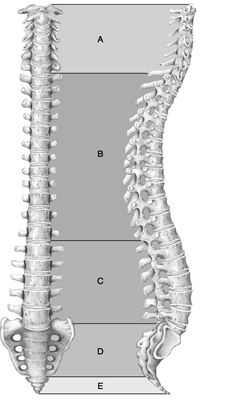B) False
Correct Answer

verified
Correct Answer
verified
Multiple Choice
Which of the following is not a movement that can occur between vertebrae?
A) flexion and extension
B) lateral flexion
C) rotation
D) supination
F) C) and D)
Correct Answer

verified
Correct Answer
verified
Multiple Choice
Thoracic vertebrae differ from the other vertebrae in that they have ________.
A) no transverse processes
B) costal facets
C) transverse foramina
D) no intervertebral discs
F) A) and C)
Correct Answer

verified
Correct Answer
verified
Short Answer
The medial condyle of the femur articulates with the medial condyle of the ________.
Correct Answer

verified
Correct Answer
verified
Short Answer
 Figure 7.1
Using Figure 7.1, match the following:
-Transverse foramina present.
Figure 7.1
Using Figure 7.1, match the following:
-Transverse foramina present.
Correct Answer

verified
Correct Answer
verified
True/False
The largest and strongest bone of the face is the maxilla.
B) False
Correct Answer

verified
Correct Answer
verified
Essay
Describe the differences between the bones of the lower and upper limb and briefly state why these differences exist.
Correct Answer

verified
The lower limbs carry the weight of the ...View Answer
Show Answer
Correct Answer
verified
View Answer
Essay
If the hyoid bone is not attached to another bone why is it so important?
Correct Answer

verified
The hyoid acts as an attachment point fo...View Answer
Show Answer
Correct Answer
verified
View Answer
Essay
Sam is an accountant who is especially busy during tax season. By the end of each day he complains of shoulder stiffness and tightness as well as some upper back pain. What might be Sam's problem and how could he prevent the discomfort?
Correct Answer

verified
Sam is probably sitting hunched over his...View Answer
Show Answer
Correct Answer
verified
View Answer
Short Answer
The ________ is the bone confined to the septum of the nose.
Correct Answer

verified
Correct Answer
verified
Multiple Choice
What is the major function of the intervertebral discs?
A) absorb shock
B) string the vertebrae together
C) prevent hyperextension of the spine
D) prevent hyperextension
F) None of the above
Correct Answer

verified
Correct Answer
verified
Short Answer
The smallest short bone in the hand is the ________.
Correct Answer

verified
Correct Answer
verified
Multiple Choice
The ethmoid bone is composed of all of the following except the ________.
A) superior nasal concha
B) crista galli
C) cribriform plate
D) inferior nasal concha
F) None of the above
Correct Answer

verified
Correct Answer
verified
True/False
The lacrimal bones contain openings that allow the tear ducts to pass.
B) False
Correct Answer

verified
Correct Answer
verified
Essay
Describe the composition of the intervertebral discs.
Correct Answer

verified
Intervertebral discs are composed of an ...View Answer
Show Answer
Correct Answer
verified
View Answer
Multiple Choice
What makes up the axial skeleton?
A) the skull, vertebral column, and pelvis
B) arms, legs, hands, and feet
C) the skull, vertebral column, and rib cage
D) shoulder and pelvic girdles
F) C) and D)
Correct Answer

verified
Correct Answer
verified
Essay
Why is the area just distal to the tubercles of the humerus called the surgical neck?
Correct Answer

verified
This area is called the surgic...View Answer
Show Answer
Correct Answer
verified
View Answer
Short Answer
 Figure 7.1
Using Figure 7.1, match the following:
-Attach to ribs.
Figure 7.1
Using Figure 7.1, match the following:
-Attach to ribs.
Correct Answer

verified
Correct Answer
verified
True/False
In women of childbearing age, the dimensions of the True pelvis are of utmost importance.
B) False
Correct Answer

verified
Correct Answer
verified
Multiple Choice
Which vertebra does not have a body?
A) last lumbar
B) axis
C) atlas
D) last cervical
F) B) and D)
Correct Answer

verified
Correct Answer
verified
Showing 61 - 80 of 121
Related Exams